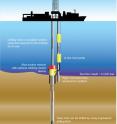IODP introduces technology to support deepwater crustal drilling
The Integrated Ocean Drilling Program (IODP), in collaboration with industry partner AGR Drilling Services, has engineered an ultra-deepwater drilling technology for use by IODP drilling vessels in scientific research. Originally developed for shallow-water oil and gas exploration, the "riserless mud recovery" technology (RMR™) holds great promise for scientists striving to reach the long-held goal of Project Mohole in the 1950s: drilling all the way through ocean crust into the Earth's mantle; a frontier not yet explored today. Drilled cores from the mantle could provide scientists with answers to questions about the structure, composition, mineralogy, and in situ physical properties of oceanic crust and the geological nature of the seismic Moho. "With AGR Drilling Services' support," says Engineering Manager Greg Myers, "IODP led an engineering effort to adapt existing technology to drill very deep holes in very deep regions of the ocean. Up to now," he adds, "riserless mud recovery drilling was limited to shallower water depths. This ultra-deepwater drilling technology allows scientists to investigate subseafloor areas in great depths, where oceanic crust may be thinner—such as in waters off Hawaii." According to Myers, an ultra-deepwater RMR™ system could be implemented as early as July 2011.
The RMR™ technology, owned by AGR, is expected to operate in hyper-deepwater depths greater than 12,000 feet. Funding for preliminary engineering was provided by the DeepStar Consortium, a deepwater industry group that supports deepwater technology development projects and leverages the industry's financial and technical resources.
"This ultra-deepwater drilling technology is environmentally friendly," says David Hine, AGR Vice President of Sales and Marketing. "It operates with a 'zero-discharge' system, leaving no cuttings or mud behind." (See Fig. 1)
In December 2005, scientists aboard IODP Expedition 312 approached mantle depths while drilling to investigate superfast seafloor spreading rates. The research expedition penetrated volcanic rock (gabbros) and reached a fossil magma chamber lying 1.4 kilometers beneath the seafloor. The Moho, or mantle, lies beneath the gabbros layer of ocean crust at depths that vary from about 5-10 km. beneath the ocean floor, to about 40 km. beneath the continents, to as much as 70 km. beneath some mountain ranges.
Source: Integrated Ocean Drilling Program Management International
Other sources
- Technology To Support Deepwater Crustal Drillingfrom Science DailyFri, 7 Aug 2009, 2:14:40 UTC
- New Technology Could Drill Deeper Into the Earth Than Ever Beforefrom PopSciTue, 4 Aug 2009, 21:28:11 UTC
- IODP introduces technology to support deepwater crustal drillingfrom Science BlogTue, 4 Aug 2009, 13:56:23 UTC
- IODP Introduces Technology to Support Deepwater Crustal Drillingfrom Newswise - ScinewsTue, 4 Aug 2009, 13:28:05 UTC
